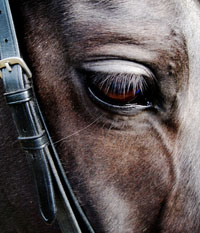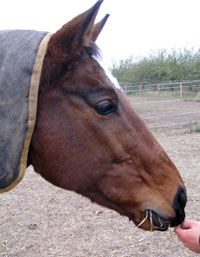Most of us realise that Ragwort needs to be eliminated from our horse's pasture due to the risk of poisoning . It's a noxious weed that quickly grows from the small "rosette" to a tall flowering plant.
Ragwort contains pyrrolizidine alkaloids compounds that are poisonous to most animals. When Ragwort is eaten it is changed by the intestines and then broken down by the liver, the breakdown products formed in the liver are toxic, it is damage to liver cells that can, if sufficient ragwort is consumed be cumulative to the point of death.
as the Ragwort grows the leaves become wavier, as you can see in the photographs the adult leaves below are quite different to those of the young plant above.
The daisy like yellow flowers appear from May to October
Is Ragwort Poisonous?
Yes Ragwort is a poisonous plant. Ragwort contains pyrrolizidine alkaloids compounds that are poisonous to most animals. When Ragwort is eaten it is changed by the intestines and then broken down by the liver, the breakdown products formed in the liver are toxic, it is damage to liver cells that can, if sufficient ragwort is consumed be cumulative to the point of death.
How toxic is Ragwort?
Ragwort contains pyrrolizidine alkaloids which are poisonous when eaten, these alkaloids do not accumulate in the body but they do cause liver damage if consumed in very large doses or over a period of time. It is the damage to the liver that kills. Scientific research has shown that a horse or pony would need to consume between 5 % and 25% of it's own body weight in Ragwort to succomb to Ragwort poisioning.
Will my horse die if it has eaten Ragwort?
Eating Ragwort can lead to incurable liver damage and death however a horse would need to eat a considerable amount (see How toxic is Ragwort) before this happened so if you keep your fields free of Ragwort and make sure you feed good quality Ragwort free forage this is unlikely to happen.
Will my horse eat Ragwort?
It doesn't taste good so most equines will avoid eating Ragwort in the field although some do develop a taste for it and they may eat it if there is nothing else to eat. The real danger is when Ragwort is cut and dried, it becomes much more palatable. So always make sure you keep any plants or leaves that you've removed out of reach and make sure your hay / haylage is Ragwort free.
Is Ragwort poisionous to humans?
Not unless you plan on eating it! It's the pyrrolizidine alkaloids that can cause liver damage but these are not toxic unless consumed. Occasionally some people will have an allergic reaction to Ragwort that causes dermatitis so if your're worried about this wear gloves when handling Ragwort.
I've read that there are 6,500 horse deaths a year from Ragwort poisioning is this true?
No there is no evidence to substantiate the claim that 6,500 horses die each year from Ragwort poisioning and the Advertising Standards Authority who regulate advertisements in the UK have stopped companies selling ragwort related products from using this figure.
How many horses die of Ragwort poisioning?
There have been 10 confirmed deaths by Ragwort poisioning between 2005 and 2010.
Is it true that landowners have to remove Ragwort by law?
No there is no legislation that states that landowners must remove Ragwort from their land this misconception arises from the fact that Ragwort is classed as an "injurious" weed and thus covered by the Weeds Act 1959.
"(1) Where the minister of Agriculture fish and food (in this act referred to as ' the Minister') is satisfied that there are injurious weeds to which this act applies growing upon any land he may serve upon the occupier of the land a notice, to take such action as may be necessary to prevent the weeds from spreading."
My nieghbour has Ragwort on their land and I don't want it spreading to mine what can I do?
Firstly speak to them about your concerns and ask if they will remove it if necessary you could ask for permission to remove it yourself. If this fails you can report the matter to Defra using the following complaint form on the DEFRA website: Weeds Act 1959 - Complaint Form (WEED2/WEED2A). they will then access the risk and decide if it is necessary to issue the landowner with an order to remove the ragwort.
Signs of Ragwort poisoning : include weight loss, weakness, sleepiness, yawning, incoordination, yellowish discoloration to mucous membranes (icterus), neurologic problems such as aimless walking, chewing motions, head pressing. Animals may appear to be normal at first, then become suddenly affected; the syndrome progresses rapidly over a few days to a week. Liver damage, depression, anorexia, vomiting, diarrhea, muddy mucous membranes, weakness, ataxia.
How to identify Ragwort
The Ragwort plant grows in a cirular cluster of leaves often described as a rosette,
(Photograph courtesy My Equestrian World)
as the Ragwort grows the leaves become wavier, as you can see in the photographs the adult leaves below are quite different to those of the young plant above.
The daisy like yellow flowers appear from May to October
and if allowed to go to seed each plant can produce 150,000 seeds, with a 70% germination rate.
Ragwort seeds can lie dormant in the ground for as long as 20 years.So it's important to remove Ragwort from your pasture before it goes to seed, ideally at the rosette stage.
Identification can sometimes be hindered when the plant has been stripped by caterpillars
however if you see these stripey little caterpillars munching their way through a plant it's more than likely Ragwort, the Cinnabar Moth's caterpillars favourite food.
however if you see these stripey little caterpillars munching their way through a plant it's more than likely Ragwort, the Cinnabar Moth's caterpillars favourite food.
Here are a few photographs to help aid identification, you can left click on the photographs to enlarge them.
Leaves.
Ragwort flower buds.
Ragwort flowers.
Ragwort flowers.
How to remove Ragwort from the paddock
As responsible horse owners we all need to keep our horse's grazing / turnout free from Ragwort, you'll need a Ragwort fork which can be bought from most tack shops or feed merchants, they are also readily available online for about £20.00, just search ragwort fork.
Ragwort forks are very easy to use they have been specifically developed to remove this pernicious weed quickly and easily, without the use of chemicals, they remove the whole plant including the roots, reducing the possibility for re-growth
All you need to do is place the fork near to the plant, put your foot on the ragwort fork bar and press down into the rootball of the plant then dig it out.
To dispose of the uprooted plant, put it into a paper sack and leave somewhere safe where your horse / pony or other livestock cannot get to it and leave it for a few days to wilt. It can then be burnt, if you try to burn it whilst it is still fresh it will produce a horrible smoke.
WARNINGS:
Some people have an allergic reaction to Ragwort so you are advised to wear gloves when handling it.
NEVER, EVER LEAVE UPROOTED RAGWORT IN THE FIELD OR WHERE YOUR EQUINE CAN REACH IT, RAGWORT BECOMES MORE PALATABLE WHEN WILTED OR DRIED AND YOUR HORSE OR PONY IS MORE LIKELY TO EAT IT.
Ragwort FAQ's
Is Ragwort Poisonous?
Yes Ragwort is a poisonous plant. Ragwort contains pyrrolizidine alkaloids compounds that are poisonous to most animals. When Ragwort is eaten it is changed by the intestines and then broken down by the liver, the breakdown products formed in the liver are toxic, it is damage to liver cells that can, if sufficient ragwort is consumed be cumulative to the point of death.
How toxic is Ragwort?
Ragwort contains pyrrolizidine alkaloids which are poisonous when eaten, these alkaloids do not accumulate in the body but they do cause liver damage if consumed in very large doses or over a period of time. It is the damage to the liver that kills. Scientific research has shown that a horse or pony would need to consume between 5 % and 25% of it's own body weight in Ragwort to succomb to Ragwort poisioning.
Will my horse die if it has eaten Ragwort?
Eating Ragwort can lead to incurable liver damage and death however a horse would need to eat a considerable amount (see How toxic is Ragwort) before this happened so if you keep your fields free of Ragwort and make sure you feed good quality Ragwort free forage this is unlikely to happen.
Will my horse eat Ragwort?
It doesn't taste good so most equines will avoid eating Ragwort in the field although some do develop a taste for it and they may eat it if there is nothing else to eat. The real danger is when Ragwort is cut and dried, it becomes much more palatable. So always make sure you keep any plants or leaves that you've removed out of reach and make sure your hay / haylage is Ragwort free.
Is Ragwort poisionous to humans?
Not unless you plan on eating it! It's the pyrrolizidine alkaloids that can cause liver damage but these are not toxic unless consumed. Occasionally some people will have an allergic reaction to Ragwort that causes dermatitis so if your're worried about this wear gloves when handling Ragwort.
I've read that there are 6,500 horse deaths a year from Ragwort poisioning is this true?
No there is no evidence to substantiate the claim that 6,500 horses die each year from Ragwort poisioning and the Advertising Standards Authority who regulate advertisements in the UK have stopped companies selling ragwort related products from using this figure.
How many horses die of Ragwort poisioning?
There have been 10 confirmed deaths by Ragwort poisioning between 2005 and 2010.
Is it true that landowners have to remove Ragwort by law?
No there is no legislation that states that landowners must remove Ragwort from their land this misconception arises from the fact that Ragwort is classed as an "injurious" weed and thus covered by the Weeds Act 1959.
"(1) Where the minister of Agriculture fish and food (in this act referred to as ' the Minister') is satisfied that there are injurious weeds to which this act applies growing upon any land he may serve upon the occupier of the land a notice, to take such action as may be necessary to prevent the weeds from spreading."
My nieghbour has Ragwort on their land and I don't want it spreading to mine what can I do?
Firstly speak to them about your concerns and ask if they will remove it if necessary you could ask for permission to remove it yourself. If this fails you can report the matter to Defra using the following complaint form on the DEFRA website: Weeds Act 1959 - Complaint Form (WEED2/WEED2A). they will then access the risk and decide if it is necessary to issue the landowner with an order to remove the ragwort.
To receive our monthly horse care tips in your in box simply send us a quick email using Newsletter as the subject. We will only ever send you our newsletters, we won't spam you and we won't share your email with anyone else and you can unsubscribe at any time. Want to see what you'll get, in February we wrote about rodent control Rodent Control around the stableyard / barn - newsletter




